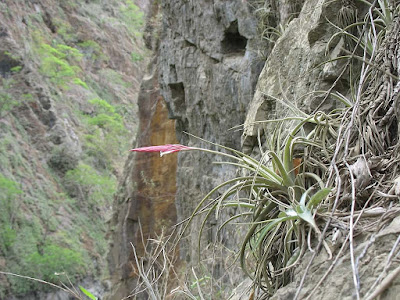Tillandsia lorentziana is native to Bolivia, Brazil, Paraguay and Argentina. It is found at altitudes between 700 and over 2500 meters above sea level.
Tillandsia lorentziana, also called as Tillandsia lorentzii, is a species of the genus Tillandsia. This species was described by August Heinrich Rudolf Grisebach in 1874.
IDENTIFY TILLANDSIA LORENTZIANA AIR PLANT
Tillandsia lorentziana is native to Bolivia, Brazil, Paraguay and Argentina. It is found at altitudes between 700 and over 2500 meters above sea level.
It is an epiphyte or caulescent saxicolous that can become quite large (more than 50 cm during flowering) with quite numerous, flexible, triangular leaves in open gutter. The leaves are polystic and arranged in a helix, those of the base of the plant are sharply curved. Sheaths a little darker, barely distinguishable from the limb. The leaves are a beautiful whitish green, sometimes slightly greyish.
This air plant bloom from the medium (15 cm), single or bipinnate inflorescence with one or more flattened and more or less loose ears. The bracts of the flowering stem are stuck to the stem, scaly with pink undertones. The floral bracts are a beautiful pink almost red, with little or no scales. The flowers are non-tubular, about 3 cm long, very beautiful, white with the tip of the petals sometimes slightly bluish. The stamens and pistil are included.
TILLANDSIA LORENTZIANA AIR PLANT CARE AND CULTURE
Cultural information should only be used as a guide, and should be to be adapted to suit you. Your physical location; where you grow your plants, how much time you have to devote to their care, and many other factors, will need to be taken into account. Only then can you decide on the cultural methods that best suit you and your plants.
Light:
Tillandsia lorentziana requires good light and enjoys full sun (avoid the afternoon in summer if the plant is young or has not been used).
Temperature:
The required temperature ranging from 10 to 32°C. Get it early enough in the fall if you grow it outside, so that it does not face night temperatures below 4 or 5 ° C, especially if it is wet. The plants can faced temperatures close to 0 ° C (sheltered and dry) for a few hours without damage.
Humidity:
This species need the moderate level of humidity. Good aeration is required, the plant must dry quickly (in less than an hour).
Substrate, growing media and repotting:
Tillandsia lorentziana can be grow suspended or mounted on a solid substrate that does not retain water. You can glue the plant directly to the surface with a strong adhesive, or you can wire the plant to the base. Don't cover the base of the plant with moss or it may rot. It can be grown on almost any imaginable decorative mount, including shells, rocks, slate, driftwood, etc.
Watering:
Twice a week in summer, once a week in winter according to the luminosity and the ambient humidity. Obviously when it rains and if you grow it outside, it counts as a watering.
Fertilizer:
This air plant is quite greedy in fertilizer and can be fertilized with the moderate doses, give it 2 to 3 times a month in the summer and 1 time a month maximum in the winter.

















COMMENTS